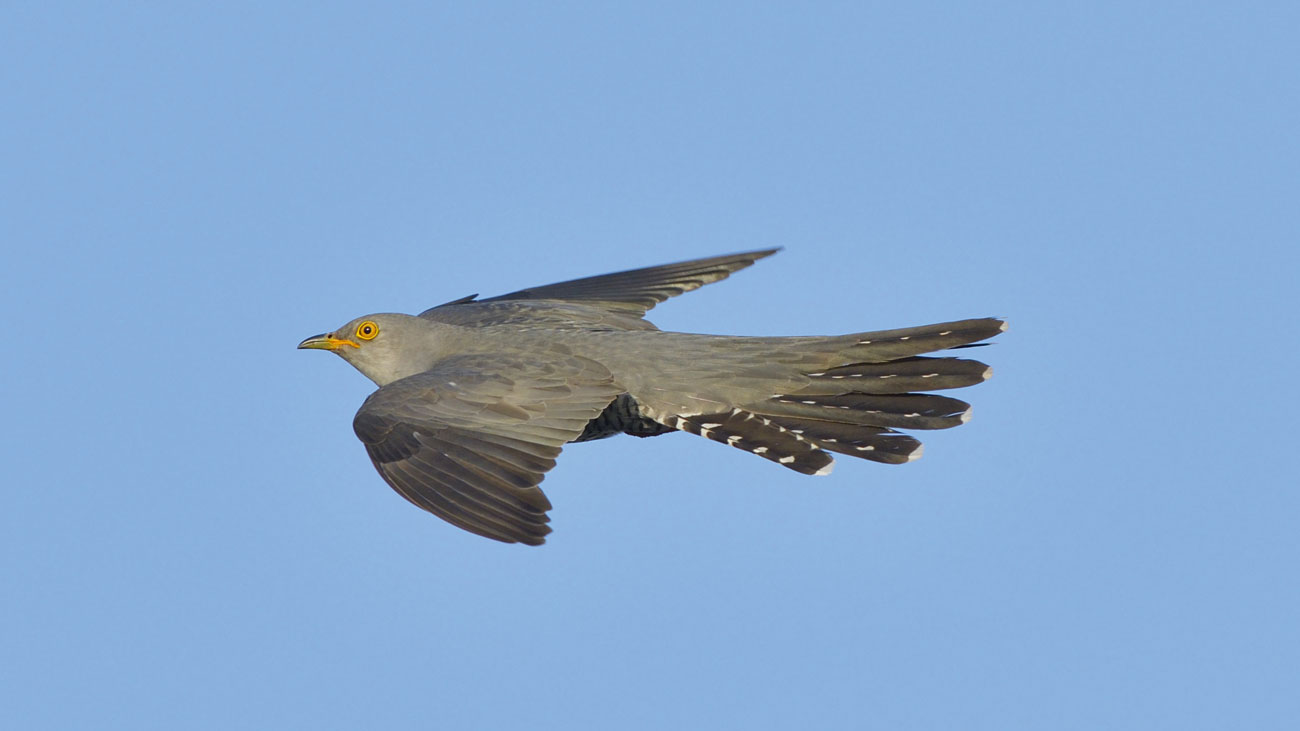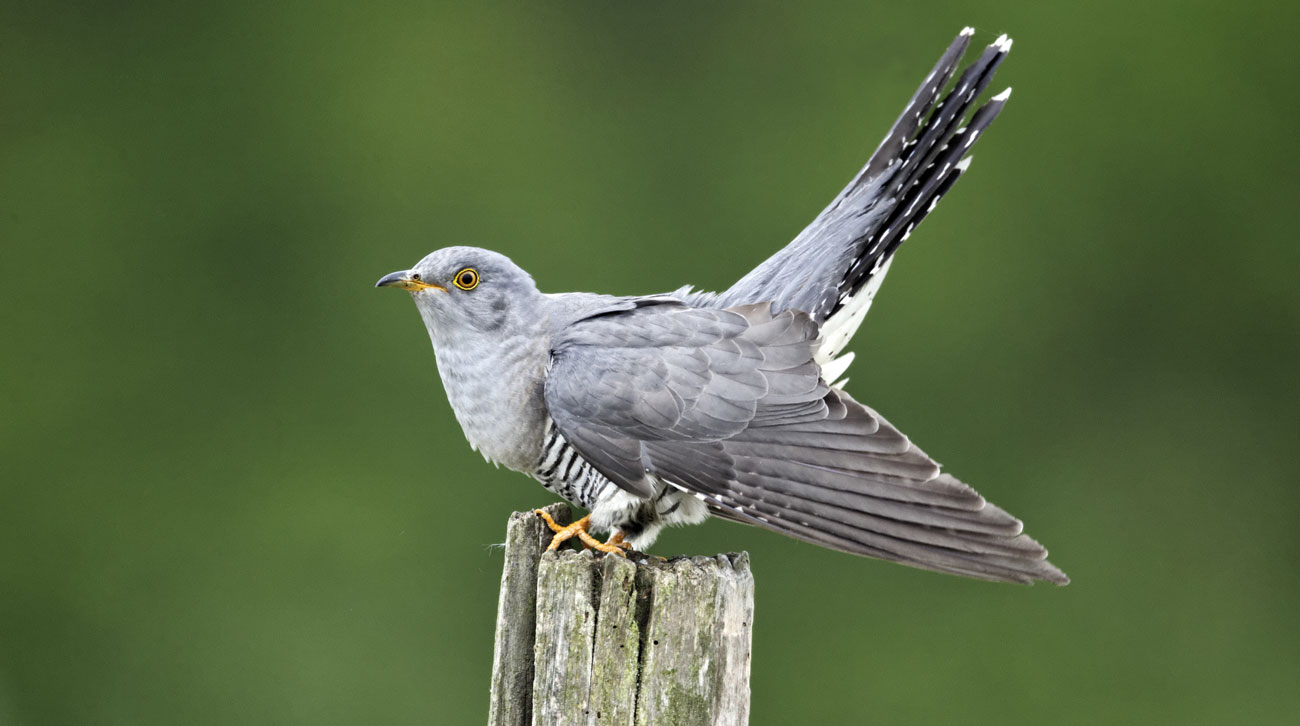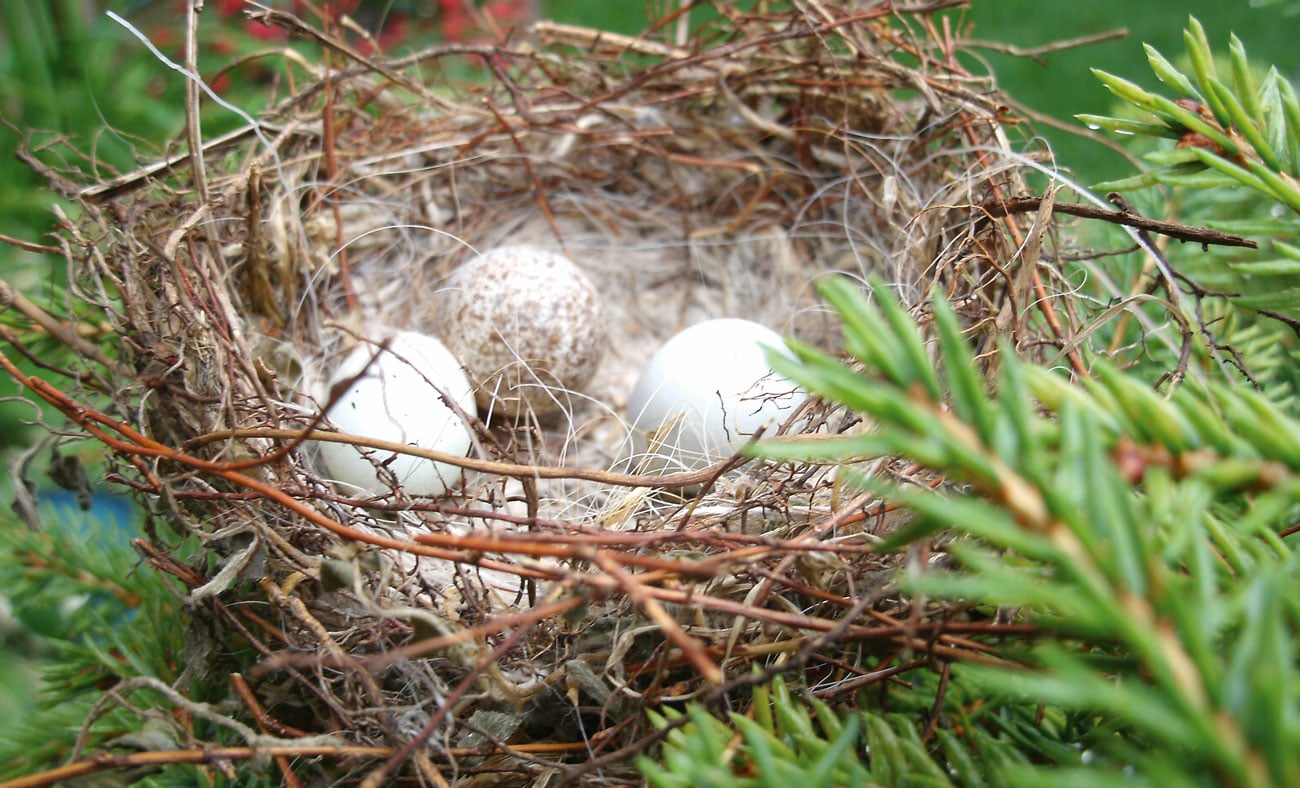
Cuckoo (Cuculus canorus)
Early May, a Surrey woodland floor blazing with bluebells, fresh lime-coloured leaves emerging from the beeches, and rafts of sunlight shining down through the fast disappearing spaces of the canopy.
And to compliment the wonder of it all, an amazing voice erupts, dwarfing the choir of local Wrens, Dunnocks, Blackbirds, Song Thrushes, and Robins. ‘Cuckoo! Cuckoo! Cuckoo’. Yes, the harbinger of Spring, subject of much poetry and folklore, is back!
I first became aware of this incredible bird when I was aged four. In my friend’s parents’ dining room was a mysterious ‘house’ on the wall. It was an antique Cuckoo clock, from the Black Forest in Germany.
Suddenly a little wooden door in the front of it opened and out popped a model Cuckoo, calling as many times as was needed to indicate the arrival of a new hour. With a last bow and a dropping of wings he disappeared back inside the clock and the door shut after him. Gone until the next o’clock!
I had to wait some years before I caught up with a real Cuckoo and that was during a holiday at an archaeological site in Cornwall. A greyish looking male flew past, fast and low, over the ancient drystone walls. That was marvellous enough but it was chasing another bird of the same shape. But this was a different colour.
The guide who was showing us around pointed out that this was the rare reddish ‘hepatic’ form of Cuckoo, which is only seen occasionally, and only in females. I have never been fortunate enough to see another one in Britain since.
Cuckoos are generally heard rather than viewed unless you search for them. The best time to hear the male is around dawn and at dusk. On many days he is the last bird singing. They must make use of every hour because they do not stay here very long. Females make a strange, excited bubbling call.

Cuckoo (Cuculus canorus)
The male’s voice carries from afar so you could well be in for a long walk to find the singer. But by imitating this I have occasionally managed to tempt an inquisitive bird to fly in my direction and give a deafening performance just yards away from my hiding place. Magic moments!
This year I heard my first Cuckoo pretty much on cue in mid-April. This early summer visitor is widespread in small numbers but has been declining for many decades. In the last 25 years we have lost over half of our Cuckoos in the UK.
Often the Cuckoo is heard in the Cranleigh area before other parts of Surrey – around 12 April onwards, perhaps due to our southerly position in a rural area of the county. The earliest I am aware of was 8 April in 2002 while the latest was 4 July 1992.
It has bred but how successfully is unknown. Female Cuckoos don’t just lay in any old nest, they lay in the nest of the same species that raised them. In the Cranleigh area we have ‘Dunnock’ Cuckoos and ‘Wren’ Cuckoos.
Other Cuckoos who rely on different host species pass through the area to take advantage of birds that don’t breed here, such as the Reed Warbler. Perhaps these birds are some of the earliest arrivals because I find the first to call invariably move on after their initial fanfare. A lull in Cuckoo calls follows for a few days until ‘our’ birds arrive.
I am aware of two cases of ‘Dunnock’ Cuckoos locally. One at Ewhurst in 1986 was hatched in a Dunnock’s nest next to a house. It successfully ‘begged’ a mouthful of worms from a passing Blackbird.
Another was photographed being fed by a Dunnock at Whipley Manor Farm in June 1994, while in this century a young Cuckoo was seen being fed by a much-overworked Wren in the Hurtwood, near Cranleigh. The tiny foster parent had to stand on the fully-grown infant’s head to get near its gaping mouth.

Common Cuckoo egg (centre)
By the time the young Cuckoos are ready to leave the nest their parents may already be well on their way back to western Africa. They’ve done their job. As many as 20 eggs or more may have been laid during the season.
Satellite tagging by the British Trust for Ornithology in recent years has revealed birds from the UK migrate using two different routes at night.
Some go via Spain and Morocco – the westerly route apparently used by all our Cuckoos heading north in Spring. Others fly via Italy or the Balkans before converging in the Congo rainforest. Those flying the former direction left an average of eight days later than the others but were more likely to die before a Sahara crossing, although their route was 12% shorter to this point.
It is a complex jigsaw to come up with a full picture but it seems most deaths on the westerly route happened where you might not expect – in Europe. Perhaps the reasons are relatively recent or the birds might have learned to take the safer route by now.
There are various theories about the causes – changing conditions at stopover sites, droughts and fires in Spain, and declines in their favoured food – large moth caterpillars.
No doubt Cuckoo numbers have also been affected by the increased scarcity, or absence, of host species they used to rely on.
I’ll be listening out for the Cuckoo for a few weeks yet. But hardly will we be into June before his call begins to change, going off key and adding the odd extra squeaky ‘cuck’.
Time to rest what must surely be a sore throat until next year. I hope he makes it back.
Twitter – @Crane_Spotter
Click here to see all of Robin Stride’s previous Crane Spotters.











